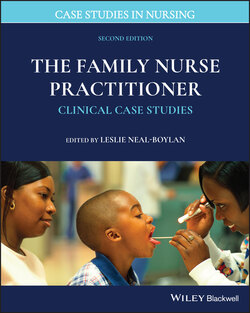Читать книгу The Family Nurse Practitioner - Группа авторов - Страница 22
ОглавлениеCase 2.4 Heart Murmur
By Mikki Meadows‐Oliver, PhD, RN, FAAN
SUBJECTIVE
Jonathan, a 12‐month‐old infant, presents to the primary care office for a well‐child visit. He is accompanied by his parents. His mother is concerned that Jonathan is eating less than usual but says that he is drinking his normal amount. His activity level has not changed.
Birth history: Jonathan was born at 39 weeks’ gestation. His birth weight was 3200 g. There were no complications during the labor or delivery. The mother had no infections, falls, or known exposures to environmental hazards. She did not drink alcohol, take prescription medication (other than prenatal vitamins), use tobacco products, or use illicit drugs. The immediate neonatal period was unremarkable. Jonathan was discharged at 2 days of age to home with his mother.
The social history reveals that Jonathan was born to a 23‐year‐old single mother. His father is involved but does not reside in the household. Jonathan lives in an apartment with his mother and 19‐year‐old cousin. The maternal grandmother (MGM) lives in the neighborhood and is able to help Jonathan’s mother with child care. The family receives assistance from governmental subsidies such as the Women, Infants, and Children supplemental nutrition program (WIC), Temporary Assistance for Needy Families (TANF), and Medicaid. Educationally, both Jonathan’s mother and father have high school diplomas. She works at a fast‐food restaurant. Jonathan’s father works as a construction worker. The family has no pets. There are no smokers in the home.
Diet: Jonathan eats a balanced diet of table foods. He still breastfeeds but is transitioning to whole milk. He takes a daily multivitamin.
Elimination: 4–6 wet diapers daily with 1 bowel movement.
Sleep: Takes one 2‐hour nap daily and sleeps 12 hours at night.
Family medical history: PGF (age 54): healthy; PGM (age 53): diabetes mellitus; MGF (age 46): high blood pressure; MGM (age 44): asthma; mother (age 23): asthma; father (age 32): healthy.
Medications: Currently taking no prescription, herbal, or over‐the‐counter medications.
Immunizations: Up to date.
Allergies: No known allergies to food, medications, or environment.
OBJECTIVE
Vital signs: Weight: 10 kg; length: 84 cm; temperature: 37°C (axillary).
General: Alert; well nourished; well hydrated; interactive.
Skin: Clear with no lesions noted; no cyanosis of lips, nails, or skin; no diaphoresis noted; good skin turgor.
Head: Normocephalic; anterior fontanel is open and flat (1 cm × 1 cm).
Eyes: Red reflexes present bilaterally; pupils equal, round, and reactive to light; no discharge noted.
Ears: Pinnae normal; tympanic membranes gray bilaterally with positive light reflex.
Nose: Both nostrils are patent; no discharge.
Oropharynx: Mucous membranes are moist; no teeth are present; no lesions.
Neck: Supple; no nodes.
Respiratory: RR = 24; clear in all lobes; no adventitious sounds noted; no retractions; no deformities of the thoracic cage noted.
Cardiac/Peripheral vascular: HR = 120; vibratory, systolic, grade 2 heart murmur noted on exam at the lower left sternal border area of the chest with both the bell and diaphragm; heard best in the supine position; no heaves or thrills noted; no radiation of the murmur to the back or axilla; brachial and femoral pulses present and 2+ bilaterally.
Abdomen/Gastrointestinal: Soft, nontender, nondistended, no evidence of hepatosplenomegaly.
Genitourinary: Normal circumcised male genitalia; testes descended bilaterally.
Back: Spine straight.
Ext: Full range of motion of all extremities; warm and well perfused; capillary refill < 2 seconds.
Neurologic: Good strength and tone.
CRITICAL THINKING
1 Which diagnostic or imaging studies should be considered to assist with or confirm the diagnosis?___Chest radiograph___Echocardiogram___Electrocardiogram
2 What is the most likely differential diagnosis and why?___Patent ductus arteriosus (PDA)___Ventricular septal defect (VSD)___Still’s murmur
3 What is the plan of treatment, referral, and follow‐up care?
4 Are there any referrals needed?
5 Does the patient’s psychosocial history impact how you might treat him?
6 What if this baby were a girl?
7 What if this baby were 6 months old?
8 Are there any standardized guidelines that should used to assess or treat this case?
